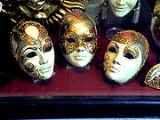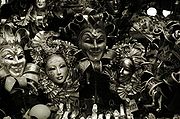
Venetian mask
Encyclopedia


Venice
Venice is a city in northern Italy which is renowned for the beauty of its setting, its architecture and its artworks. It is the capital of the Veneto region...
, Italy
Italy
Italy , officially the Italian Republic languages]] under the European Charter for Regional or Minority Languages. In each of these, Italy's official name is as follows:;;;;;;;;), is a unitary parliamentary republic in South-Central Europe. To the north it borders France, Switzerland, Austria and...
. The mask
Mask
A mask is an article normally worn on the face, typically for protection, disguise, performance or entertainment. Masks have been used since antiquity for both ceremonial and practical purposes...
s are typically worn during the Carnevale (Carnival of Venice
Carnival of Venice
The Carnival of Venice is an annual festival, held in Venice, Italy. The Carnival starts 40 days before easter and ends on Shrove Tuesday , the day before Ash Wednesday.-History:...
), but have been used on many other occasions in the past, usually as a device for hiding the wearer's identity and social status.
The mask would permit the wearer to act more freely in cases where he or she wanted to interact with other members of the society outside the bounds of identity and everyday convention. It was useful for a variety of purposes, some of them illicit or criminal, others just personal, such as romantic encounters.
Venetian masks are characterised by their ornate design, featuring bright colours such as gold or silver and the use of complex decorations in the baroque
Baroque
The Baroque is a period and the style that used exaggerated motion and clear, easily interpreted detail to produce drama, tension, exuberance, and grandeur in sculpture, painting, literature, dance, and music...
style. Many designs of Venetian masks stem from Commedia dell'arte
Commedia dell'arte
Commedia dell'arte is a form of theatre characterized by masked "types" which began in Italy in the 16th century, and was responsible for the advent of the actress and improvised performances based on sketches or scenarios. The closest translation of the name is "comedy of craft"; it is shortened...
. They can be full-face masks (e.g. the bauta) or eye masks (e.g. the Columbina).
History
Near the end of the Republic, the wearing of masks in daily life was severely restricted. By the 18th century, it was limited only to about three months from December 26. The masks were traditionally worn with decorative beads matching in colour.Bauta
Bauta (sometimes referred as baùtta) is a mask which covers the whole face, this was a traditional piece of art, with a stubborn chin line, no mouth, and lots of gilding. The mask has a square jaw line often pointed and tilted upwards to enable the wearer to talk, eat and drink easily without having to remove the mask thereby preserving their anonymity. The Bauta was often accompanied by a red cape and a tricorn.In 18th century, the Bauta had become a standardized society mask and disguise regulated by the Venetian government. It was obligatory to wear it at certain political decision-making events when all citizens were required to act anonymously as peers. Only citizens had the right to use the Bauta. Its role was similar to the anonymizing processes invented to guarantee general, direct, free, equal and secret ballots in modern democracies.
It was not allowed to wear weapons along with the mask, and police had the right to enforce this ruling.
Columbina
The Columbina (also known as Columbine and Columbino) is a half mask often highly decorated with gold, silver, crystals and feathers. It is held up to the face by a baton or tied with ribbon as with most other Venetian masks. The columbine was popularised by an early actress in the Commedia dell'arteCommedia dell'arte
Commedia dell'arte is a form of theatre characterized by masked "types" which began in Italy in the 16th century, and was responsible for the advent of the actress and improvised performances based on sketches or scenarios. The closest translation of the name is "comedy of craft"; it is shortened...
of the same name. It is said it was designed for her because she did not wish to have her beautiful face covered completely.
Medico Della Peste (The Plague Doctor)
The Medico Della Peste with its long beak is one of the most bizarre and recognisable of the Venetian masks. The striking design has a macabre history originating from 17th century French physician Charles de LormeCharles de Lorme
Charles de Lorme, Delorme, d'lorm, or De l'Orme , was a medical doctor. Charles was the son of Jean Delorme , who was the primary doctor to Marie de' Medici. This ultimately opened doors for Charles' medical career soon after he graduated from the University of Montpellier in 1607 at the age of 23...
who adopted the mask together with other sanitary precautions while treating plague victims. The mask is white consisting of a hollow beak and round eye holes covered with crystal discs creating a bespectacled effect.
Today, the masks are often more decorative. The doctors who followed de Lorme's example wore the usual black hat and long black cloak as well as the mask, white gloves and a stick (to move patients without having to come into physical contact). They hoped these precautions would prevent them contracting the disease. Those who wear the plague doctor mask often also wear the associated clothing of the plague doctor. The popularity of the Medico della Peste among carnivale celebrants can be seen as a memento mori
Memento mori
Memento mori is a Latin phrase translated as "Remember your mortality", "Remember you must die" or "Remember you will die". It names a genre of artistic work which varies widely, but which all share the same purpose: to remind people of their own mortality...
.
Moretta
Popular in Venice as it brought out the beauty of feminine features such as the female head, body and mind. The mask was held in place by the wearer biting on a button or bit and was finished off with a veil. Servetta Muta translates as 'mute maid servant'. This mask has not been widely worn since 1760.Volto (Larva)
The larva, also called the volto mask, is mainly white, and typically Venetian. It is worn with a tricorn and cloak. It is thought the word "larva" comes from the Latin meaning "mask" or "ghost". Like the bauta, the shape of the mask allowed the wearer to breathe, drink, and speak easily without having to remove the mask. These masks were made of fine wax cloth and so were light and comfortable to wear, making them ideal for a night of socializing and dancing.In popular culture
Venetian masks feature prominently in the film Eyes Wide ShutEyes Wide Shut
Eyes Wide Shut is a 1999 drama film based upon Arthur Schnitzler's 1926 novella Traumnovelle . The film was directed, produced and co-written by Stanley Kubrick, and was his last film. The story, set in and around New York City, follows the sexually-charged adventures of Dr...
. In the film, the main character (played by Tom Cruise
Tom Cruise
Thomas Cruise Mapother IV , better known as Tom Cruise, is an American film actor and producer. He has been nominated for three Academy Awards and he has won three Golden Globe Awards....
) infiltrates a masked ball where high ranking individuals engage in secret orgies and masonic
Freemasonry
Freemasonry is a fraternal organisation that arose from obscure origins in the late 16th to early 17th century. Freemasonry now exists in various forms all over the world, with a membership estimated at around six million, including approximately 150,000 under the jurisdictions of the Grand Lodge...
rituals.
Stores that supplied the masks include both Ca’ Macana and Il Canovaccio in Venice. The latter displays the original mask worn in the film by Tom Cruise on their website.

